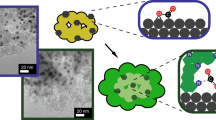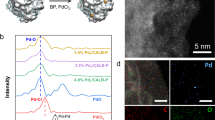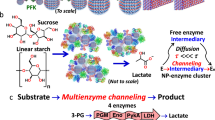Abstract
Building a bridge between enzymatic and heterogeneous catalysis provides new cascade industrial processes for manufacturing. However, the reaction conditions of enzymatic and heterogeneous catalysis mutually cause deactivation of catalysts. Here, we overcame this challenge by developing a special protocol for the synthesis of hybrid catalysts. We utilized protein–polymer nanoconjugates as confined nanoreactors for the in situ synthesis of lipase–palladium (Pd) nanohybrids. The 0.8 nm Pd nanoparticles exhibited increased activity in racemization of (S)-1-phenylethylamine. At 55 °C, which matches the optimum temperature of lipase, the activity is more than 50 times that of commercial Pd/C. It was found that the Pd–O coordination in Pd subnanoclusters contributed to the high activity. In the dynamic kinetic resolutions of pharmaceutical intermediates (±)-1-phenylethylamine, (±)-1-aminoindan and (±)-1,2,3,4-tetrahydro-1-naphthylamine, the lipase–Pd nanohybrids displayed 7.6, 3.1 and 5.0 times higher efficiencies than the combination of commercial immobilized lipase Novozym 435 and Pd/C. The lipase–Pd nanohybrids can be reused without agglomeration and activity loss.
This is a preview of subscription content, access via your institution
Access options
Access Nature and 54 other Nature Portfolio journals
Get Nature+, our best-value online-access subscription
$29.99 / 30 days
cancel any time
Subscribe to this journal
Receive 12 digital issues and online access to articles
$119.00 per year
only $9.92 per issue
Buy this article
- Purchase on Springer Link
- Instant access to full article PDF
Prices may be subject to local taxes which are calculated during checkout





Similar content being viewed by others
Data availability
The data that support the plots within this paper and other findings of this study are available from the corresponding author upon request.
References
Ye, R., Zhao, J., Wickemeyer, B. B., Toste, F. D. & Somorjai, G. A. Foundations and strategies of the construction of hybrid catalysts for optimized performances. Nat. Catal. 1, 318–325 (2018).
Litman, Z., Wang, Y., Zhao, H. & Hartwig, J. F. Cooperative asymmetric reactions combining photocatalysis and enzymatic catalysis. Nature 560, 355–359 (2018).
Dydio, P. et al. An artificial metalloenzyme with the kinetics of native enzymes. Science 354, 102–106 (2016).
Verho, O. & Bäckvall, J. E. Chemoenzymatic dynamic kinetic resolution: a powerful tool for the preparation of enantiomerically pure alcohols and amines. J. Am. Chem. Soc. 137, 3996–4009 (2015).
Efrati, A. et al. Assembly of photo-bioelectrochemical cells using photosystem I-functionalized electrodes. Nat. Energy 1, 15021–15027 (2016).
Zhang, H. et al. Bacteria photosensitized by intracellular gold nanoclusters for solar fuel production. Nat. Nanotechnol. 13, 900–905 (2018).
Rudroff, F. et al. Opportunities and challenges for combining chemo- and biocatalysis. Nat. Catal. 1, 12–22 (2018).
Denard, C. A. et al. Cooperative tandem catalysis by an organometallic complex and a metalloenzyme. Angew. Chem. Int. Ed. 126, 475–479 (2014).
Denard, C. A., Hartwig, J. F. & Zhao, H. Multistep one-pot reactions combining biocatalysts and chemical catalysts for asymmetric synthesis. ACS Catal. 3, 2856–2864 (2013).
Groeger, H. & Hummel, W. Combining the ‘two worlds’ of chemocatalysis and biocatalysis towards multi-step one-pot processes in aqueous media. Curr. Opin. Chem. Biol. 19, 171–179 (2014).
Fu, H. et al. Chemoenzymatic asymmetric synthesis of the metallo-β-lactamase inhibitor aspergillomarasmine A and related aminocarboxylic acids. Nat. Catal. 1, 186–191 (2018).
Reetz, M. T. & Schimossek, K. Lipase-catalyzed dynamic kinetic resolution of chiral amines: use of palladium as the racemization catalyst. CHIMIA 50, 668–669 (1996).
Engström, K. et al. Co-immobilization of an enzyme and a metal into the compartments of mesoporous silica for cooperative tandem catalysis: an artificial metalloenzyme. Angew. Chem. Int. Ed. 52, 14006–14010 (2013).
Kim, M. J. et al. Dynamic kinetic resolution of primary amines with a recyclable Pd nanocatalyst for racemization. Org. Lett. 9, 1157–1159 (2007).
Paetzold, J. & Bäckvall, J. E. Chemoenzymatic dynamic kinetic resolution of primary amines. J. Am. Chem. Soc. 127, 17620–17621 (2005).
Thalén, L. K. et al. A chemoenzymatic approach to enantiomerically pure amines using dynamic kinetic resolution: application to the synthesis of norsertraline. Chem. Eur. J. 15, 3403–3410 (2009).
Parvulescu, A. N., Jacobs, P. A. & De Vos, D. E. Heterogeneous Raney nickel and cobalt catalysts for racemization and dynamic kinetic resolution of amines. Adv. Synth. Catal. 350, 113–121 (2008).
Blacker, A. J., Stirling, M. J. & Page, M. I. Catalytic racemisation of chiral amines and application in dynamic kinetic resolution. Org. Process. Res. Dev. 11, 642–648 (2007).
Strohmeier, G. A. et al. Application of designed enzymes in organic synthesis. Chem. Rev. 111, 4141–4164 (2011).
Renata, H., Wang, Z. J. & Arnold, F. H. Expanding the enzyme universe: accessing non-natural reactions by mechanism-guided directed evolution. Angew. Chem. Int. Ed. 54, 3351–3367 (2015).
Sheldon, R. A. & van Pelt, S. Enzyme immobilisation in biocatalysis: why, what and how. Chem. Soc. Rev. 42, 6223–6235 (2013).
Zhu, J. et al. Temperature-responsive enzyme–polymer nanoconjugates with enhanced catalytic activities in organic media. Chem. Commun. 49, 6090–6092 (2013).
J. Thiele, M. et al. Enzyme–polyelectrolyte complexes boost the catalytic performance of enzymes. ACS Catal. 8, 10876–10887 (2018).
vander Straeten, A. et al. Protein–polyelectrolyte complexes to improve the biological activity of proteins in layer-by-layer assemblies. Nanoscale 9, 17186–17192 (2017).
Zhang, Y., Wang, Q. & Hess, H. Increasing enzyme cascade throughput by pH-engineering the microenvironment of individual enzymes. ACS Catal. 7, 2047–2051 (2017).
Cheng, H. et al. Combination cancer treatment through photothermally controlled release of selenous acid from gold nanocages. Biomaterials 178, 517–526 (2018).
Gustafson, K. P., Lihammar, R., Verho, O., Engström, K. & Bäckvall, J. E. Chemoenzymatic dynamic kinetic resolution of primary amines using a recyclable palladium nanoparticle catalyst together with lipases. J. Org. Chem. 79, 3747–3751 (2014).
Xu, G., Dai, X., Fu, S., Wu, J. & Yang, L. Efficient dynamic kinetic resolution of arylamines with Pd/layered double-hydroxide-dodecyl sulfate anion for racemization. Tetrahedron Lett. 55, 397–402 (2014).
Vasan, H. N. & Rao, C. N. R. Nanoscale Ag–Pd and Cu–Pd alloys. J. Mater. Chem. 5, 1755–1757 (1995).
Ayyappan, S. et al. Nanoparticles of Ag, Au, Pd, and Cu produced by alcohol reduction of the salts. J. Mater. Res. 12, 398–401 (1997).
Xie, J., Zheng, Y. & Ying, J. Y. Protein-directed synthesis of highly fluorescent gold nanoclusters. J. Am. Chem. Soc. 131, 888–889 (2009).
Tan, Y. N., Lee, J. Y. & Wang, D. I. C. Uncovering the design rules for peptide synthesis of metal nanoparticles. J. Am. Chem. Soc. 132, 5677–5686 (2010).
Selvakannan, P. R. et al. Capping of gold nanoparticles by the amino acid lysine renders them water-dispersible. Langmuir 19, 3545–3549 (2003).
Filice, M., Marciello, M., del Puerto Morales, M. & Palomo, J. M. Synthesis of heterogeneous enzyme–metal nanoparticle biohybrids in aqueous media and their applications in C–C bond formation and tandem catalysis. Chem. Commun. 49, 6876–6878 (2013).
Görbe, T. et al. Design of a Pd(0)–CalB CLEA biohybrid catalyst and its application in a one-pot cascade reaction. ACS Catal. 7, 1601–1605 (2017).
Schüth, F., Ward, M. D. & Buriak, J. M. Common pitfalls of catalysis manuscripts submitted to chemistry of materials. Chem. Mater. 30, 3599–3600 (2018).
Yu, H. et al. The XAFS beamline of SSRF. Nucl. Sci. Technol. 26, 050102 (2015).
Lee, J. H. et al. Chemoenzymatic dynamic kinetic resolution of alcohols and amines. Eur. J. Org. Chem. 2010, 999–1015 (2010).
Eigtved, P. Immobilization of lipase by adsorption on a particulate macroporous. US patent No. 5,156,963 (1992).
Adlercreutz, P. Immobilisation and application of lipases in organic media. Chem. Soc. Rev. 42, 6406–6436 (2013).
Zaks, A. & Klibanov, A. M. The effect of water on enzyme action in organic media. J. Biol. Chem. 263, 8017–8021 (1988).
Wu, X., Yang, C. & Ge, J. Green synthesis of enzyme/metal–organic framework composites with high stability in protein denaturing solvents. Bioresour. Bioproc. 4, 24 (2017).
Parvulescu, A., De Vos, D. & Jacobs, P. Efficient dynamic kinetic resolution of secondary amines with Pd on alkaline earth salts and a lipase. Chem. Commun. 42, 5307–5309 (2005).
Parvulescu, A. N., Jacobs, P. A. & De Vos, D. E. Palladium catalysts on alkaline-earth supports for racemization and dynamic kinetic resolution of benzylic amines. Chem. Eur. J. 13, 2034–2043 (2007).
Jin, Q. et al. Modification of supported Pd catalysts by alkalic salts in the selective racemization and dynamic kinetic resolution of primary amines. Catal. Sci. Technol. 4, 464–471 (2014).
Kresse, G. & Hafner, J. Ab initio molecular dynamics for liquid metals. Phys. Rev. B 47, 558–561 (1993).
Kresse, G. & Furthmüller, J. Efficiency of ab-initio total energy calculations for metals and semiconductors using a plane-wave basis set. Comp. Mater. Sci. 6, 15–50 (1996).
Kresse, G. & Furthmüller, J. Efficient iterative schemes for ab initio total-energy calculations using a plane-wave basis set. Phys. Rev. B 54, 11169–11186 (1996).
Perdew, J. P., Burke, K. & Ernzerhof, M. Generalized gradient approximation made simple. Phys. Rev. Lett. 77, 3865–3868 (1996).
Kresse, G. & Joubert, D. From ultrasoft pseudopotentials to the projector augmented-wave method. Phys. Rev. B 59, 1758–1775 (1999).
Acknowledgements
This work was supported by the National Key Research and Development Plan of China (2016YFA0204300), the National Natural Science Foundation of China (21622603, 21878174 and 51573085) and the Beijing Natural Science Foundation (JQ18006). The authors thank beamline BL14W1 (Shanghai Synchrotron Radiation Facility) for providing the beam time.
Author information
Authors and Affiliations
Contributions
J.G., H.X. and R.N.Z. supervised the project. J.G. and X.L. conceived the idea. X.L. performed the experiments with technical help from Y.S. and J.X. Y.C performed the calculations. K.L. performed the mass spectra analyses. J.M., Z.L. and J.L. participated in analysing the results. X.L., L.W., J.G., H.X. and R.N.Z. co-wrote the paper.
Corresponding authors
Ethics declarations
Competing interests
The authors declare no competing interests.
Additional information
Publisher’s note: Springer Nature remains neutral with regard to jurisdictional claims in published maps and institutional affiliations.
Supplementary Information
Supplementary Information
Supplementary Methods, Supplementary Tables 1–10, Supplementary Figs. 1–52 and Supplementary References
Supplementary Data 1
Cartesian coordinates Pd_111_phenylethylamine
Supplementary Data 2
Cartesian coordinates Pd_111_imine
Supplementary Data 3
Cartesian coordinates Pd/(1/1/1)_partial_oxidation_phenylethylamine
Supplementary Data 4
Cartesian coordinates Pd/(1/1/1)_partial_oxidation_imine
Supplementary Data 5
Cartesian coordinates CALB_Pluronic_initial
Supplementary Data 6
Cartesian coordinates CALB_Pluronic_final
Rights and permissions
About this article
Cite this article
Li, X., Cao, Y., Luo, K. et al. Highly active enzyme–metal nanohybrids synthesized in protein–polymer conjugates. Nat Catal 2, 718–725 (2019). https://doi.org/10.1038/s41929-019-0305-8
Received:
Accepted:
Published:
Issue Date:
DOI: https://doi.org/10.1038/s41929-019-0305-8
This article is cited by
-
Pickering emulsion droplets and solid microspheres acting synergistically for continuous-flow cascade reactions
Nature Catalysis (2024)
-
Multi-compartmental MOF microreactors derived from Pickering double emulsions for chemo-enzymatic cascade catalysis
Nature Communications (2023)
-
Active and stable alcohol dehydrogenase-assembled hydrogels via synergistic bridging of triazoles and metal ions
Nature Communications (2023)
-
Hydrolase mimic via second coordination sphere engineering in metal-organic frameworks for environmental remediation
Nature Communications (2023)
-
Light Controlled Nanobiohybrids for Modulating Chiral Alcohol Synthesis
Applied Biochemistry and Biotechnology (2023)



